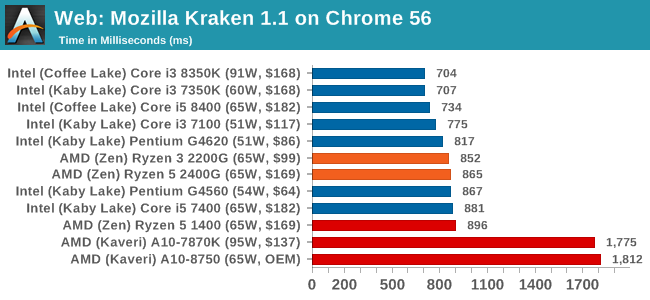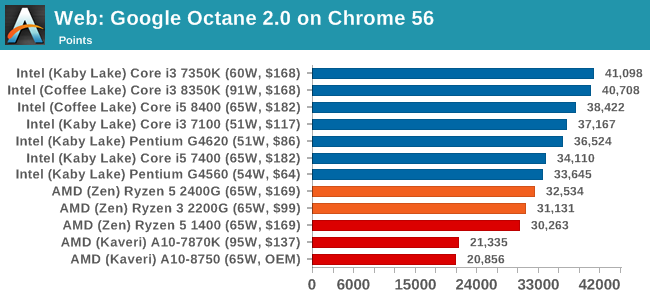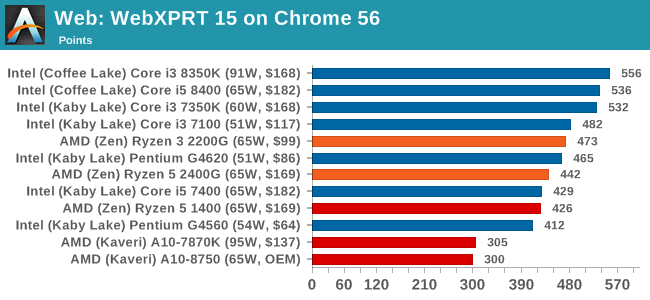Marrying Vega and Zen: The AMD Ryzen 5 2400G Review
by Ian Cutress on February 12, 2018 9:00 AM ESTBenchmarking Performance: CPU Web Tests
One of the issues when running web-based tests is the nature of modern browsers to automatically install updates. This means any sustained period of benchmarking will invariably fall foul of the 'it's updated beyond the state of comparison' rule, especially when browsers will update if you give them half a second to think about it. Despite this, we were able to find a series of commands to create an un-updatable version of Chrome 56 for our 2017 test suite. While this means we might not be on the bleeding edge of the latest browser, it makes the scores between CPUs comparable.
All of our benchmark results can also be found in our benchmark engine, Bench.
Mozilla Kraken 1.1: link
Kraken is a Javascript based benchmark, using the same test harness as SunSpider, but focusing on more stringent real-world use cases and libraries, such as audio processing and image filters. Again, the basic test is looped ten times, and we run the basic test four times.

With the newer high-performance cores, AMD gets a fair crack at benchmarks like Mozilla, where it historically lagged behind with its Bulldozer-family architecture.
Google Octane 2.0: link
Along with Mozilla, as Google is a major browser developer, having peak JS performance is typically a critical asset when comparing against the other OS developers. In the same way that SunSpider is a very early JS benchmark, and Kraken is a bit newer, Octane aims to be more relevant to real workloads, especially in power constrained devices such as smartphones and tablets.

In recent years, Intel has made strides on its Octane performance. So even with cores and threads, and the sizable jump up from Kaveri, AMD is still behind on this test.
WebXPRT 2015: link
While the previous three benchmarks do calculations in the background and represent a score, WebXPRT is designed to be a better interpretation of visual workloads that a professional user might have, such as browser based applications, graphing, image editing, sort/analysis, scientific analysis and financial tools.











177 Comments
View All Comments
sonicmerlin - Tuesday, February 13, 2018 - link
Now if only AMD had a competent GPU arch. The APU performance could be given a huge boost with Nvidia’s techdr.denton - Thursday, February 15, 2018 - link
They do. It's called Vega. Very efficient in mid- to low range and compute, and if I'm not mistaken that's where the money is. Highend gaming is just wi**ie waving for us geeks.HStewart - Tuesday, February 13, 2018 - link
Check out performance of up and coming i8809G with Vega Graphics compare to Ryzen 7http://cpu.userbenchmark.com/Compare/Intel-Core-i7...
Keep in mine this is a mobile chips - this is new mobile chips is quite powerful - I thinking of actually getting one - only big concern is compatibility with Vega chip.
haplo602 - Wednesday, February 14, 2018 - link
the i8809G is a desktop chip, 100W TDP ....hansmuff - Tuesday, February 13, 2018 - link
Any idea where I could buy the MSI B350I Pro AC? I have searched every retailer I've ever bought from and can not find the damn thing. I'm hoping it can run a 2400G out of the box, at least to update to the newest BIOS.Dragonstongue - Tuesday, February 13, 2018 - link
they REALLY should not have cut back the L3 cache SO MUCH...beyond that, truly are amazing for what they are...they should have also made a higher TDP version such as 125-160w so they could cram more cpu cores or at very least a more substantial graphics portion and not limit dGPU access to 8x pci-e (from what I have read)Graphics cards and memory are anything but low cost.
2200 IMO is "fine" for what it is, the 2400 should have had at least 4mb l3 cache (or more) then there should have been "enthusiast end" with the higher TDP versions so they could more or less ensure someone trying to do it "on a budget" really would not have to worry about getting anything less than (current) RX 570-580 or 1060-1070 level.
many cpu over the years (especially when overclocked) had a 140+w TDP, they could have and should have made many steps for their Raven Ridge and not limit them so much..IMO...they could have even had a frankenstein like one that has a 6pin pci-e connector on it to feed more direct power to the chip instead of relying on the socket alone to provide all the power needed (at least more stable power)
AM4 socket has already been up to 8 core 16 thread, and TR what 16 core 32 thread says to me the "chip size" has much more room available internally to have a bigger cpu portion and/or a far larger GPU portion, now, if they go TR4 size, TR as it is already has 1/2 of it "not used" this means they could "double up" the vega cores in it to be a very much "enthusiast grade" APU, by skimping cost on the HBM memory and relying on the system memory IMO there is a vast amount of potential performance they can capture, not to mention, properly designed, the cooling does not really become an issue (has not in the past with massive TDP cpu afterall)
anyways..really is very amazing how much potency they managed to stuff into Raven Ridge, they IMO should not have "purposefully limited it" especially on the L3 cache amount, 2mb is very limiting as far as I am concerned especially when trying to feed 4 core 8 thread at 65w TDP alojng with the gpu portion.
Either they are asking a bit much for the 2400g or, they are asking enough they just need to "tweak" a bit more quickly to make sure it is not bottlenecking itself for the $ they want for it ^.^
either way, very well done....basically above Phenom II and into Core i7 level performance with 6870+ level graphics grunt using much less power...amazing job AMD...Keep it up.
SaturnusDK - Wednesday, February 14, 2018 - link
Well done AMD. Well done.Both these APUs are extremely attractive. The R5 just screams upgradable. You get a very capable 4 core / 8 thread CPU packaged with an entry level dGPU for less than the competition charges for the CPU (with abyssmal iGPU) alone. In the current market with astronomical, even comical, dGPU prices this is a clear winner for anyone wanting to build a powerful mid-tier system but doesn't have the means to fork out ridiculous cash for higher tier dGPU now.
The R3 scream HTPC or small gaming box. A good low end CPU paired with a bare bones but still decently performing iGPU. Add MB, RAM, PSU, and HDD/SSD and you're good to go. I imagine these will sell like hot cakes in markets with less overall GDP and in the brick'n'mortar retail market.
The question is now. Is Intel ever going to produce a decent iGPU for the low end market? They've had plenty of time to do so but before Ryzen, AMD APUs just wasn't that attractive. Now though, you really have to think hard for a reason to justify buying a low end Intel CPU at all.
yhselp - Wednesday, February 14, 2018 - link
"Now with the new Ryzen APUs, AMD has risen that low-end bar again."You had to do it. I understand. And thank you.
dr.denton - Thursday, February 15, 2018 - link
<3Hifihedgehog - Wednesday, February 14, 2018 - link
I have been doing some digging and found that although current-generation AM4 motherboards lack formal HDMI 2.0 certification, just like many HDMI 1.4 cables will pass an HDMI 2.0 signal seamlessly without a hitch, the same appears to be the case for these boards whose HDMI traces and connectors may indeed be agnostic to the differences, if any. Could you do a quick test to see if HDMI 2.0 signals work for the Raven Ridge APUs on the AM4 motherboards you have access to? For further reference on the topic, see this forum thread “Raven Ridge HDMI 2.0 Compatibility — AM4 Motherboard Test Request Megathread” at SmallFormFactor.